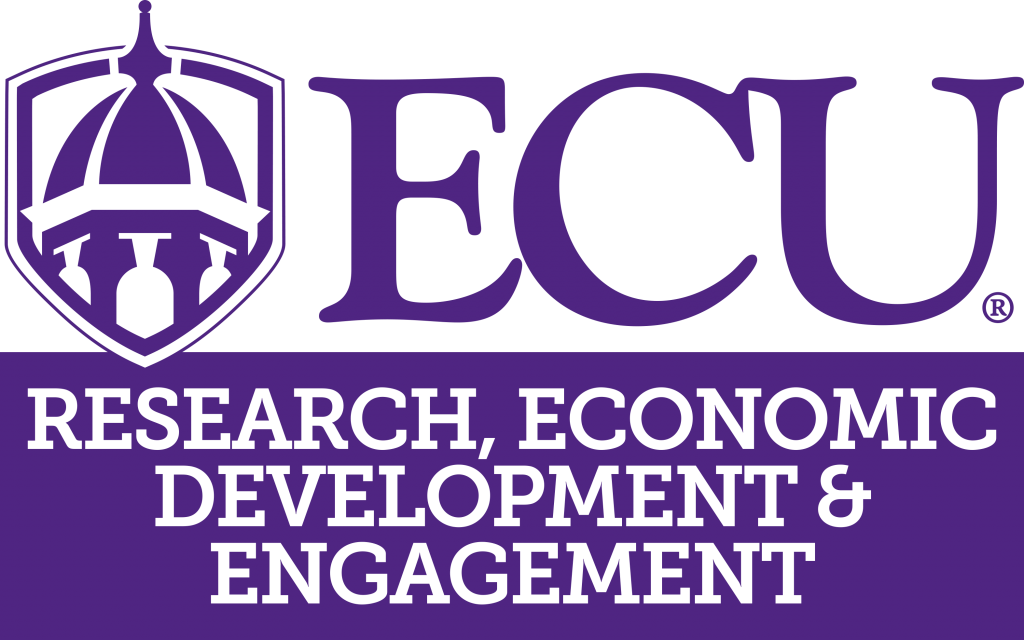COVID Ramp Up2
Important Guidance and Forms
- Office of Environmental Health and Safety: COVID-19 Research Restart
- ECU Guidelines for Fieldwork in the COVID-19 Pandemic
- Student Research Risk and Liability Release
Goal: To keep everyone safe while increasing research activity in a phased approach as safety becomes easier to maintain.
This document refers to research conducted in research spaces, including the physical campus and campus owned/leased spaces, field stations and nature reserves, or with direct contact with individuals (human subjects) anywhere. The document does not cover research that can be done entirely remotely. On-campus research includes physical presence in campus libraries, archives and museums to access any university material that cannot be accessed remotely, as well as performance work (arts) or other studio access that must be done on campus.
- Principle No. 1: Follow the cognizant local, state and national public health authority directives to shelter at home and implement social distancing.
- Principle No. 2: Protect the health and safety of the research workforce, emotional as well as physical. Protect the health and safety of our clinical patients and human research subjects.
- Principle No. 3: Protect the careers of early stage researchers.
- Principle No. 4: Undergraduates are students first, researchers second.
- Principle No. 5: Implement a fair and transparent process for granting access.
- Principle No. 6: Ensure as rapid a research restart as the public health conditions permit.
- Principle No. 7: Participate in finding cures and preventions for COVID-19, while increasing safe access to participants for research studies and clinical trials.
Phases and Permitted Research Activities
The six-stage phasing description and tabular representation an adaptation of the University of Washington’s research restitution plan, taking into account Gov. Cooper’s three-phase plan for re-opening North Carolina. The phased description was developed by the University of California’s vice chancellor for research and has been shared widely with the APLU Committee on Research. Lower phases are more restrictive, higher phases less so.
Public health directives and the current state of the health care and COVID-19 public health response systems determine the timing as to when any given institution in its local context is permitted to move up or down between phases. Before allowing greater access to labs, libraries and research collections, a plan and rigorous enforcement of social distancing directives is necessary. Elements of such a plan may include (this list is intended to be illustrative, not exhaustive): scheduled/work-shift access; required facial coverings; 6-foot distancing; depending on size of research space and nature of activity therein, density limits such as one researcher per 100 square feet is justified and approved; temperature checks at start and end of work shift; disinfecting work surfaces after use; and so on.
| Phase | External Conditions | Summary and Metrics | Criteria |
|---|---|---|---|
| 1 | Situation unknown and changing. | Only research deemed critical is allowed. | Research facilities and field stations are closed, except where personnel are required to protect life safety and critical research infrastructure and capability (maintaining cell lines, animal health, instrumentation, etc.). |
| 2 | On-campus access allowed to maintain research capability or prevent catastrophic disruption. | Research access limited to social-distanced essential personnel only for priority research activities, including: Human Subjects Research In-person studies categorized as low risk studies with approved Safety Plan and Risk Assessment. In-person studies categorized as medium and higher risk by OSHA guidelines limited to studies of COVID-19 and clinical trials/research required for health and well-being of the participants. |
|
| Preparations for next phase | |||
| 3 | COVID-19 testing capacity increasing, clinical treatment protocols for COVID-19 improving, and a PPE shortage still existing. | Definition of “critical” relaxed to include time-sensitive research. | Deadline-driven research activities: Human Subjects Research In-person studies categorized as medium and high risk studies with approved Safety Plan and Risk Assessment. Very high risk studies limited to studies of COVID-19 and clinical trials/research required for health and well-being of the participants |
| Preparations for next phase | |||
| 4 | Gradually expand the number of people on campus while maintaining social distancing. Critical new on-campus research allowed, but labs/groups only allowed to operate at 50-70% total personnel capacity, with social distancing. All research activities that can be done remotely should continue to be done remotely, including all seminars, group meetings, etc. | Human Subjects Research Expanded in-person studies categorized as medium and high risk by OSHA guidelines. Very high risk studies limited to those related to COVID-19 and clinical trials/research required for health and well-being of the participants. |
|
| 5 | Continued expansion of research on campus while maintaining social distancing. | Human Subjects Research Expanded in-person studies based on approved Safety Plan and Risk Assessment. |
|
| 6 | All types of on site research are allowed. |
**These include research that will help deal with the pandemic; has the potential to lead to therapies for COVID-19; and will help the nation recover after the pandemic cases. Must file a social distancing plan.
Considerations
- Department chairs or college administration should inform Facilities Services in advance of increasing operations to ensure HVAC systems are adjusted for increased occupancy and staffing is adequate.
- Facilities will sanitize public areas, including restrooms, lobbies and other common areas, stairs, elevators, and kitchenettes. Offices and labs may receive lower attention and frequency. It would be expected occupants would sanitize their labs, offices and conference rooms.
- Trash removal, vacuuming and mopping might be less frequent.
- Laboratory staff are responsible for disinfecting lab surfaces and equipment, particularly high touch areas, utilizing guidance provided by the Centers for Disease Control.
- COVID-19 protective actions must be included in laboratory safety plans, including:
- Monitoring for COVID-19 symptoms (temperature, cough and congestion). Refer individuals with symptoms to Prospective Health;
- Physical distancing (no less than 6-foot distancing, one researcher per 100 square foot space);
- PPE consideration;
- Hygiene-washing hands;
- Disinfecting of frequently touched surfaces;
- Modified procedures that insure at least one other person in the lab; and
- More frequent laundering.
- Develop a checklist for restarting laboratory-based research. Plans should be flexible enough to enable the swift ramp down of research to an earlier phase in response to increasing incidence of COVID-19 in the community or reinstatement of stay at home orders.
- Plans must comply with physical distancing requirements and should provide for the lowest density of people reasonable to carry out research. Gatherings, including group meetings, and even one-to-one discussions, should continue to occur virtually.
- Work schedules may need to be staggered to maintain low personnel density.
- Research teams utilizing shared space must coordinate their plans.
- Any personnel returning from out of state must follow current guidance on 14-day self-quarantine prior to reporting to campus. These individuals should work from their place of quarantine to the greatest extent possible if they are asymptomatic.
- Do not restart research that requires PPE without first ensuring/acquiring an adequate supply of PPE. Start ordering PPE now, if necessary, to have on hand for restart if current stock on hand is insufficient.
- Non-critical research that generates large volumes of hazardous waste and/or involves chemical, biological, radiation or other hazardous materials should not restart until Phase 4 at the earliest.
- Carrying out research should be limited to employees and registered students. Volunteers should not be allowed to conduct research until Phase 6 is reached.
- All restart planning must consider the needs of employees/students with current disability accommodations or those who will require new accommodations
- Each PI must think carefully about which lab members will be allowed to return to work initially:
- Trainees (Ph.D. students and postdocs) should be given top priority due to the need to complete their research projects in a timely fashion.
- Priority should be given to lab staff who volunteer willingly to return to the lab.
- Consider the well-being of young trainees and staff who live alone in small apartments and might benefit greatly from the ability to come in to work.
- Consider the urgency of the work. Students or postdocs should be given high priority if they need to complete experiments to meet a thesis deadline, a paper submission or a grant submission.
- Consider occasional replacement of personnel in the schedule with new people, to allow as many lab staff as possible to enjoy some progress in their projects.
- Undergraduate volunteers will not be allowed in our laboratories for the duration of the pandemic.





